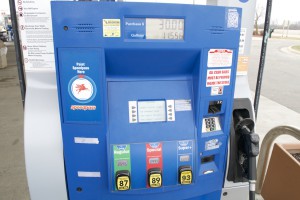With the Thanksgiving holiday underway, gasoline prices dropped slightly as motorists began filling up their tanks for what looks to be a record week for travel.
AAA reported after holding steady for nine days, the national gas price average was slowly declining at the start of the Thanksgiving week. At $2.54, the average price of gasoline was two cents less per gallon than one week ago and 40 cents more per gallon than a year ago.
While lower prices are a welcome sight for travelers, higher pump prices have not typically stopped Americans from hitting the road for holiday travel, AAA noted.
“Nearly 46 million Americans will travel more than 50 miles away from their home by car this holiday,” said Jeanette Casselano, AAA spokesperson. “Since 2014, the national gas price average has dropped one to five cents heading into the Thanksgiving week.
(Council calls for bigger investment in hydrogen. For the story, Click Here.)
The 10 states with the largest yearly increases include Alaska where prices are up 63 cents as well as by 59 cents in Illinois, by 58 cents in Indiana 58 cents, 55 cents in Minnesota and 54 cents in Wisconsin by 52 cents in California by 51 cents in Michigan by 49 cents in Kansas and by 47 cents in Iowa and Colorado.
The West Coast continues to sell the most expensive gas with Alaska $3.27 per gallon leading the region and topping all states’ gas prices
On Thursday, Nov. 16, the Keystone Pipeline was shut down due to a spill at a section of the pipeline in Marshall County, South Dakota. Over the weekend, TransCanada said that it does not yet have a potential restart date for the pipeline, which runs from Hardisty, Alberta, to Cushing, Oklahoma, and on to Wood River/Patoka, Illinois.
While the pipeline is shut down, crude oil deliveries to some Midwestern refineries that draw from the pipeline may be reduced. In addition, crude inventory levels at Cushing, may drop due to the delivery disruption. “The impact to gas prices in the Midwest will be based on the length of time the pipeline is down,” added Casselano.
Three months following Hurricane Harvey, gas prices in the South and Southeast are again among the cheapest in the country with seven states landing on this week’s top 10 states with the least expensive gas for a consecutive week.
(Click Here to see why GM thinks bigger is better when it comes to hydrogen.)
Gas prices in the Mid-Atlantic and Northeast region either are seeing no change or small declines at the pump on the week with Delaware seeing the largest decrease of 3 cents per gallon.
At the close of Friday’s formal trading session on the NYMEX, WTI increased $1.41 to settle at $56.55. The price per barrel of crude oil is likely to continue gaining throughout the week after EIA’s latest report showed that crude inputs into refineries, for production of products like gasoline, grew by 250,000 barrels per day on the week to land at 16.9 million barrels per day.
On the flip side, crude oil inventory ballooned to 1.9 million barrels, but is still lower than where it was at this time last year. Increased oil inventory and domestic crude production, which reached an all-time high at 9.65 million barrels per day last week, have contributed to growth in crude exports as they rose to 1.12 million barrels per day.
Meanwhile, the price oil appears poised to go higher after the meeting of the Organization of Petroleum Exporting Countries next week.
After recent growth in the U.S. active oil rig count, last week’s count remained unchanged at 738. This news may give market observers hope that oil prices may push even higher ahead of OPEC’s meeting on Nov. 30, in Vienna, AAA noted.
(To see why the average fuel economy of new vehicles is getting worse, Click Here.)
At the upcoming meeting, OPEC and non-OPEC member countries that are a part of the production reduction agreement to curtail supply may decide to extend the agreement beyond its current expiration date at the end of March 2018, putting upward pressure on prices provided Russia and Saudi Arabia agree to the production cuts.



The headline says oil prices but the article is about gasoline prices except for the ending. Oil prices are actually skyrocketing today not going down. So the headline is completely and accurate, and it should say gas prices anyway not well.
Point taken, Joe.
Our headline editor will be boiled in more expensive oil.
Paul E.